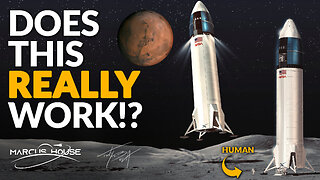Premium Only Content

Voyager Spacecraft's Terrifying NEW Discovery In Space Changes Everything!
In 1977, two spacecraft departed the earth and embarked on a mission to refine human
knowledge of the solar system. More than 40 years later, the two spacecraft still
communicate with the earth! And now, billions of miles away from us, the Voyager
mission has made a terrifying discovery! How has the mission lasted this long, and what
is the startling discovery?
Join us as we dive into Voyager Spacecraft's INSANE New discovery changes
everything!
How many technologies from the seventies still work perfectly and continuously used?
You will agree not many, as technology leaps by bounds!
Here is another question: how many devices made in the seventies still work? Maybe a
classic car that is well maintained?
Would you like to use a telephone from the seventies as your daily driver? Of course,
apart from the ornamental and sentimental value, it is pretty useless.
But what about when the device is billions of miles away from the earth and is even
going further away from us?
That is the story of the twin Voyager spacecraft! Voyager 1 and Voyager 2 left the earth
in 1977 within days of each other. Decades later, Voyager 2 is more than ten and a half
billion miles away from us! The Voyager 1, going in the opposite direction, is even
farther from us, at more than a whopping 12 billion miles away!
Yet, we get signals from them, using technology from the seventies!
To quantify how far these two spacecraft are from the earth, it takes radio signals,
traveling at the speed of light, 30 good hours to get to Voyager 2 and return! For
Voyager 2, the scientists have to wait even longer as it takes 38 hours for the two legs
of the trip!
During their sojourn in deep space, the two Voyager spacecraft have explored Jupiter,
Saturn, Uranus, and Neptune. Thanks to them, we have detailed views of these faraway
worlds, seeing their moons enveloped in ice, covered in volcanoes, and bathed in
gasoline smog!
One cool thing about the Voyagers, apart from changing our perspective of the earth, is
that they have exported human culture to the stars and whatever species is there. This
is because the two spacecraft are equipped with golden gramophone records playing
our sounds out there to anybody that cares to listen! The message includes speech,
music, sounds, and even pictures encoded in the grooves. The music consists of
classical from Bach, Beethoven, and Mozart. Surprisingly, Elvis Presley, the rave of the
moment, did not make the cut!
The Voyager spacecraft were built by NASA's Jet Propulsion Laboratory, which
operates them. The JPL is a division of Caltech in Pasadena.
Voyager 2 took off from Cape Canaveral on 20 August 1977, while Voyager 1 launched
on the 5th of the next. They took advantage of the launch window that would allow the
mission to fly by all the four giant planets.
Signals from the Voyagers are received by NASA's deep space network, which are
giant satellite dishes scattered around the world, designed to pick up data from distant
spacecraft.
The power of the transmitter on the spacecraft is around 12 watts, but when it is on high
power, it is 20 watts, the equivalent of the lightbulb on a fridge!
So anytime you struggle to receive a mobile phone signal, remember NASA has no
problem receiving messages from 12 billion miles away, using a 40 year old, 12 watt
transmitter!
The most mind-blowing thing is that each time NASA receives a signal from Voyager 1,
it is the farther any manufactured object has communicated with the earth!
Few expeditions in the entire history of humankind have produced as many scientific
achievements as the twin Voyager spacecraft. They were the first computer controlled
spacecraft to be launched. They fly themselves, run themselves, check themselves, and
even switch to backup systems by themselves!
So, how come the Voyagers are still communicating even after so many years? How
are they continuously powered?
The two Voyagers are equipped with thermoelectric electric generators. They contain
plutonium, which, being radioactive, decays. This process produces heat, converted to
the electric current that runs the Voyagers' systems.
Plutonium has a half-life of about 90 years, allowing a small quantity to produce power
for a long time!
However, the power source won't last forever because every year, four watts less heat
is produced. To keep them flying as much as possible, NASA has been turning off
redundant systems. For example, NASA only keeps the instruments that can take data
where the spacecraft are running. The cameras are shut off since it is pitch black where
they are, and there is nothing to see.
Essential processes like heating are kept running to prevent the onboard instrument
from freezing. NASA scientists believe the time to shut down the Voyagers will come
within the next ten years, or they will stop getting signals from the Voyager aircraft. If the
latter is the case, it will happen gradually as signals will continuously weaken.
-
 10:28
10:28
Future Space
2 years agoScientists Terrifying New Discovery In Egypt Changes Everything!
86 -
 1:50:51
1:50:51
Adam Carolla
5 days ago $8.27 earnedDave Portnoy RAILS against entitled, lazy Gen-Z Workforce + Comedian Dusty Slay | Adam Carolla Show
19.9K23 -
 15:00
15:00
Mrgunsngear
15 hours ago $4.02 earnedDan Wesson DWX: 2011 & CZ-75's Baby
19.5K14 -
 16:07
16:07
SKAP ATTACK
13 hours ago $2.55 earnedNuggets STEAL Game 1 Behind Jokic Mastery
28K6 -
 LIVE
LIVE
Big Fitz Plays
1 hour agoWho Gave Me a Chainsword?! | Space Marine 2 Chaos Stream
75 watching -
 22:16
22:16
marcushouse
15 hours ago $2.57 earnedFinally, the Starship Info We’ve Been Waiting For… And What We Can Do With It Is Wild!
19.4K14 -
 33:32
33:32
Ohio State Football and Recruiting at Buckeye Huddle
13 hours agoOhio State Football: What Position is the Biggest Question Mark for the Buckeyes?
19.5K2 -
 LIVE
LIVE
JahBlessGames
1 hour agoEASTER STREAM TEST
73 watching -
 9:30
9:30
VSOGunChannel
18 hours ago $1.48 earnedAdmin Actually Defending the 2nd Amendment?
17.2K10 -
 LIVE
LIVE
Biscotti-B23
3 hours ago $0.15 earned🔴 LIVE REMATCH TOURNAMENT W/ DOTODOYA ⚽ OTSUTSUKI FC VS YOUTUBE ALLSTARS
56 watching